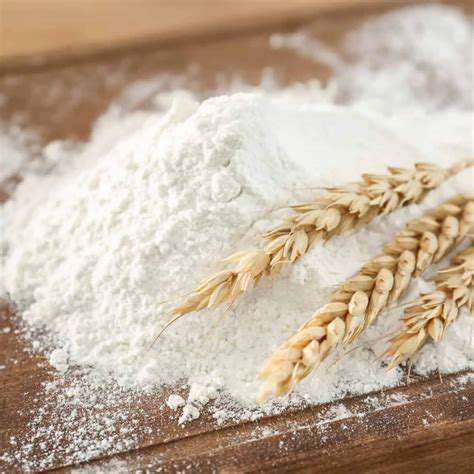Understanding Different Types of Flour: Baking Science

The Foundation of Many Dishes
Wheat flour, a staple in global kitchens, forms the base of numerous recipes. Bakers and chefs rely on its unique properties to create everything from airy cakes to crusty breads. When mixed with water, the proteins in flour develop gluten, giving dough its elasticity and structure.
This remarkable ingredient enables endless culinary possibilities. Its flexibility allows for an astonishing variety of textures and flavors in both sweet and savory creations.
Varieties and Their Unique Uses
Different wheat flours serve distinct purposes in baking and cooking. All-purpose flour works well for most recipes, offering a middle ground in terms of protein content. Bread flour, with its higher gluten potential, creates the perfect chewy texture for artisanal loaves and pizza crusts.
For delicate pastries and cakes, pastry flour provides the ideal tender crumb while still maintaining structure.
Nutrition and Wellness Benefits
Whole wheat flour delivers important nutrients including B vitamins, iron, and dietary fiber. The bran and germ in whole grain varieties contain antioxidants that may support heart health. When consumed as part of varied diet, wheat products can contribute to balanced nutrition.
Refined flours have different nutritional profiles, with some nutrients removed during processing but often enriched with certain vitamins.
From Field to Kitchen
Modern flour production combines traditional techniques with technological advances. Farmers grow specific wheat varieties suited to different end uses, while millers carefully control grinding processes. The extraction rate determines whether flour retains more whole grain components or becomes more refined.
These processing choices significantly influence the flour's performance in recipes and its nutritional content.
Cultural Importance Through History
Civilizations have cultivated wheat for millennia, making it central to many food traditions worldwide. From ancient flatbreads to contemporary artisan baking, wheat flour remains fundamental to global food culture. Its historical significance reflects humanity's agricultural and culinary evolution.
Regional variations in flour types and preparation methods showcase local adaptations and preferences.
Environmental Considerations
Sustainable wheat farming practices help reduce water usage and maintain soil health. Some producers implement crop rotation and reduced tillage to minimize environmental impact. Conscious choices in production and consumption can make wheat cultivation more ecologically responsible.
Emerging technologies aim to improve efficiency while preserving natural resources in flour production.
Beyond Wheat: Exploring Alternative Flours
Rice Flour: A Light and Versatile Option
Rice flour provides excellent gluten-free alternatives for various culinary applications. Its fine texture works beautifully in Asian desserts and crispy coatings. When blended with other ingredients, it creates light, tender baked goods with a delicate crumb structure.
The neutral taste of rice flour makes it adaptable to both sweet and savory preparations, while its easy digestibility appeals to many consumers.
Chickpea Flour: Nutrient-Dense and Flavorful
Packed with plant-based protein, chickpea flour adds nutritional value to recipes. Its distinctive earthy flavor enhances savory dishes like socca and pakoras. This flour works particularly well as a binder in veggie burgers and as a base for gluten-free flatbreads.
The high fiber content contributes to satiety while providing important minerals like iron and folate.
Almond Flour: Rich and Nutritious
Ground almonds create a flour that's naturally low in carbohydrates but high in healthy fats. The subtle nutty taste complements both desserts and crusts for meats or fish. Almond flour's moisture-retaining properties help prevent baked goods from drying out.
While more calorie-dense than grain flours, it offers vitamin E and other beneficial nutrients.
Cornstarch: The Perfect Thickener
This refined starch creates smooth, glossy textures in sauces and fillings. Its neutral flavor won't interfere with other ingredients, making it ideal for delicate custards and clear glazes. In baking, small amounts can lighten the texture of certain recipes.
Cornstarch also works well for coating foods before frying to achieve extra crispiness.
Tapioca Flour: The Secret to Chewy Textures
Derived from cassava root, this starch lends elasticity to gluten-free baked goods. It helps create the characteristic chew in Brazilian cheese bread and improves the mouthfeel of many Asian desserts. The slight sweetness enhances without overwhelming other flavors.
Tapioca flour works particularly well when combined with other alternative flours for balanced results.
Buckwheat: Robust and Earthy
Despite its name, buckwheat is unrelated to wheat and naturally gluten-free. Its distinctive flavor pairs wonderfully with hearty ingredients in pancakes and soba noodles. The dense nutritional profile includes rutin, a flavonoid with potential health benefits.
This flour adds interesting depth to recipes while providing complete plant protein.
- Quick Weeknight Meals: From Pantry to Plate
- Knife Skills for Home Cooks: Mastering Basic Cuts
- Exploring Spanish Tapas Desserts: Churros and Flan
- High Fiber Diet Benefits: Recipes for Digestive Health
- How to Store Potatoes Long Term: Cool and Dark
- High Protein Smoothies: Power Up Your Day
- How to Store Eggs for Maximum Freshness
- Storing Root Vegetables: Keep Them Fresh Longer
- How to Store Apples Long Term: Cool and Dark
- Whole30 Meal Planning: Simple and Compliant Recipes
- Homemade Granola Bars: Healthy and Portable
- Quick & Easy Breakfast Muffins: On the Go Options